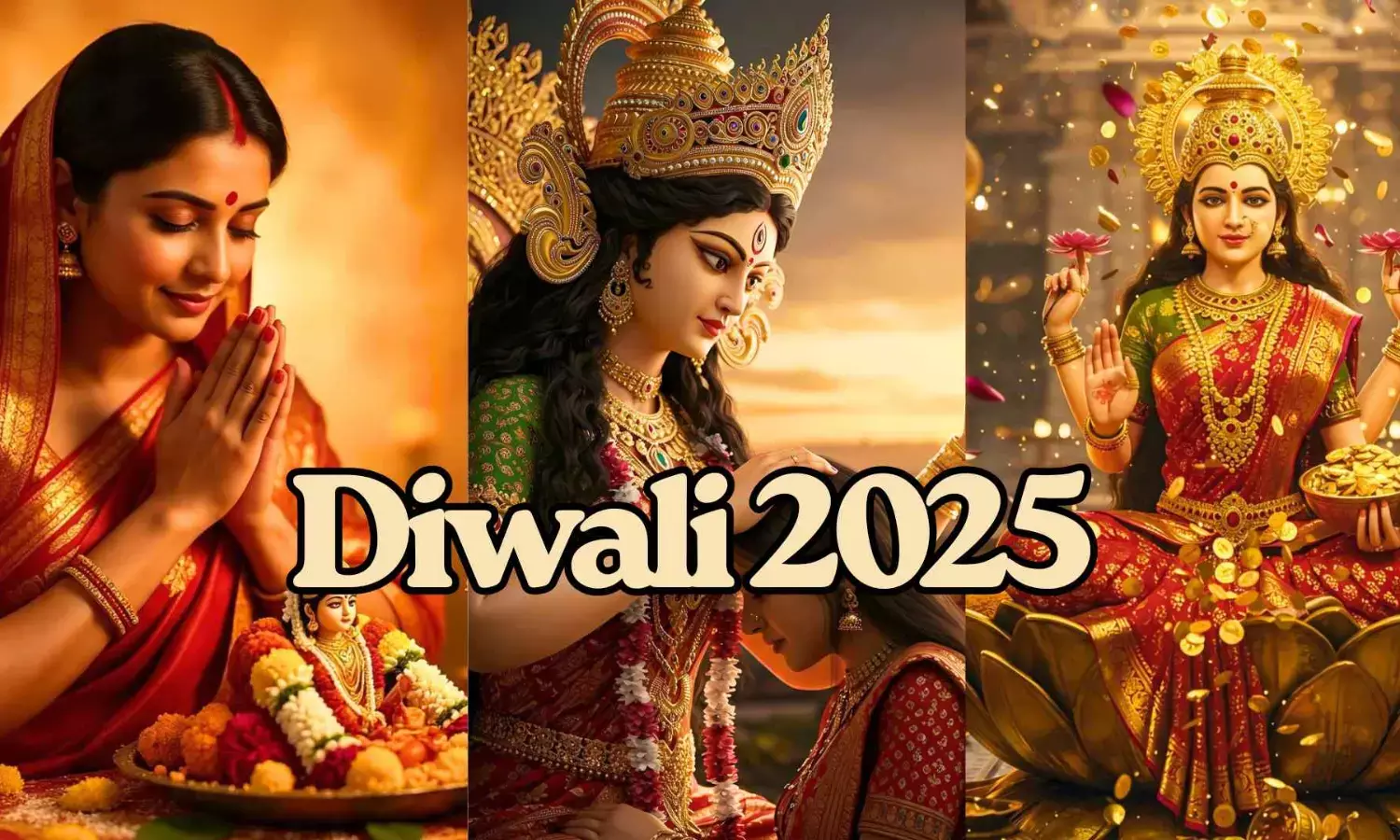Diwali 2025: The Festival of Lights and Faith — Pooja Dates, Timings & Rituals Explained

Discover the complete Diwali 2025 celebration guide — including pooja dates, tithis, timings, and rituals for Dhanteras, Kali Pooja, Diwali Lakshmi Pooja, Govardhan Pooja, Bhai Dooj, and Jagat Dhatri Pooja. Learn why Diwali is celebrated, how it’s observed, and the traditional methods behind India’s most radiant festival.
The Season of Light, Faith, and Renewal
As October 2025 approaches, India begins to prepare for its most loved and luminous festival — Diwali, or Deepavali, the Festival of Lights. Streets shimmer with diyas, homes sparkle with joy, and the air fills with the sweet aroma of mithai and devotion. But beyond the sparkle lies a profound spiritual essence — the victory of light over darkness, truth over falsehood, and knowledge over ignorance.
Why Is Diwali Celebrated ?
Diwali, the Festival of Lights, is one of the most important festivals in India. It celebrates the victory of light over darkness and good over evil.
According to Hindu mythology, Diwali marks the return of Lord Rama to Ayodhya after defeating the demon king Ravana and completing 14 years of exile. The people of Ayodhya lit rows of diyas to welcome him home, and since then, Indians celebrate Diwali by lighting lamps, decorating homes, and spreading happiness.
It is also believed that Goddess Lakshmi, the goddess of wealth, was born on this day and visits homes that are clean and well-lit to bless them with prosperity.
In India, Diwali is a time of togetherness, joy, and renewal — reminding everyone that no matter how dark life becomes, the light of goodness always shines brighter.
How Is Diwali Celebrated?
Across India, Diwali is celebrated over five main days filled with lights, rituals, family gatherings, and charity.
Homes are cleaned and decorated with rangoli, torans, and diyas, symbolizing purity and readiness to welcome Goddess Lakshmi.
New clothes are worn, sweets are exchanged, and people forgive old grudges to begin anew.
The evenings are devoted to poojas, chanting, and lighting diyas — transforming every corner of the home into a temple of light.
Here Is The Complete Diwali 2025 Pooja Schedule & Ritual Methods
1. Dhanteras – The Day of Prosperity and New Beginnings
Date: Saturday, October 18, 2025
Tithi: Trayodashi (13th day of Krishna Paksha)
Pooja Time: 6:45 PM – 8:30 PM (may vary by location)
Significance:
Dhanteras marks the start of Diwali and honors Lord Dhanvantari, the god of health, and Goddess Lakshmi, the deity of wealth. Buying gold, silver, or utensils on this day symbolizes attracting good fortune and abundance.
How to Perform Dhanteras Pooja:
1. Clean and decorate the house, especially the entrance, with rangoli and lamps.
2. Set up a clean altar with idols or pictures of Lord Dhanvantari, Lakshmi, and Kuber.
3. Light a ghee diya near the main entrance.
4. Offer fresh flowers, coins, sweets (preferably kheer or laddoo), and incense.
5. Recite “Om Shreem Mahalakshmyai Namah” 108 times.
6. End with an aarti and distribute prasad to family members.
Dhanteras reminds us that true wealth lies in health, gratitude, and devotion.
2. Kali Chaudas / Naraka Chaturdashi / Kali Pooja – The Night of Power
Date: Sunday, October 19, 2025
Tithi: Chaturdashi (14th day of Krishna Paksha)
Pooja Time: 11:00 PM – 12:30 AM
Significance:
This night honors Maa Kali, the fierce protector, and celebrates Lord Krishna’s victory over Narakasura. It represents the destruction of negativity and the awakening of inner strength.
How to Perform Kali / Naraka Chaturdashi Pooja:
1. Begin the day with an oil bath, symbolic of purification.
2. In the evening, prepare a red or black cloth altar for Maa Kali.
3. Offer red hibiscus flowers, sesame oil lamps, rice, and sweets.
4. Chant “Om Krim Kalikayai Namah” to invoke courage and clarity.
5. Perform the midnight aarti using conch shells or bells.
6. Meditate on overcoming fear and ego — the true demons within.
Kali Pooja teaches that light shines brightest after facing the darkness within.
3. Diwali / Lakshmi Pooja – The Festival of Lights and Wealth
Date: Monday, October 20, 2025
Tithi: Amavasya (New Moon)
Pooja Muhurat: 6:45 PM – 8:25 PM (local variation)
Significance:
This is the main day of Diwali, dedicated to Goddess Lakshmi, Lord Ganesha, and Lord Kuber — the deities of wealth, wisdom, and prosperity.
How to Perform Lakshmi Pooja:
1. Clean every corner of the house and decorate with marigold flowers and diyas.
2. Spread a red cloth on a raised platform and place idols of Lakshmi and Ganesha.
3. Draw a swastika and place coins or jewelry as a symbol of abundance.
4. Offer fruits, dry fruits, sweets, betel leaves, and flowers.
5. Recite Lakshmi Chalisa or Sri Suktam with family.
6. Perform aarti and light diyas in every room, especially near windows and entrances.
7. Share sweets and happiness with friends, family, and neighbors.
The essence of Diwali lies in remembering that clean hearts attract divine light more than clean homes.
4. Govardhan Pooja / Annakut – The Day of Gratitude
Date: Wednesday, October 22, 2025
Tithi: Pratipada (1st day of Shukla Paksha)
Pooja Time: Morning after sunrise
Significance:
Govardhan Pooja honors Lord Krishna’s act of lifting the Govardhan Hill to protect his devotees. It celebrates gratitude toward nature and the food that sustains us.
How to Perform Govardhan Pooja:
1. Create a small Govardhan hill from cow dung or clay.
2. Decorate it with flowers, grass, and food offerings.
3. Prepare a large variety of dishes known as Annakut (mountain of food).
4. Offer butter, curd, milk, and tulsi leaves to Lord Krishna.
5. Perform aarti and walk around the symbolic hill in devotion.
6. Distribute Annakut food among family, friends, and those in need.
This pooja symbolizes humility, thankfulness, and eco-conscious living.
5. Bhai Dooj – The Bond of Sibling Love
Date: Friday, October 24, 2025
Tithi: Dwitiya (2nd day of Shukla Paksha)
Pooja Time: Morning to afternoon
Significance:
Bhai Dooj celebrates the sacred relationship between brothers and sisters — where love, protection, and blessings unite the family.
How to Perform Bhai Dooj Ritual:
1. Sisters prepare a pooja thali with sandalwood, rice, diya, and sweets.
2. Brothers sit facing east while sisters apply a tilak on their forehead.
3. Sisters perform aarti and pray for their brothers’ long life.
4. Brothers give gifts or money in return, promising to protect their sisters.
5. The day ends with a festive family meal filled with laughter and love.
Bhai Dooj reflects that family bonds are the true light of life.
6. Jagat Dhatri (Jagaddhatri) Pooja – The Goddess Who Sustains the Universe
Date: Saturday, November 1, 2025
Tithi: Shukla Navami
Pooja Time: Morning to noon
Significance:
After the vibrant festivities of Diwali, eastern India celebrates Jagat Dhatri Pooja, honoring the goddess who restores balance in the universe. She represents courage, calm, and compassion after chaos.
How to Perform Jagat Dhatri Pooja:
1. Place an idol or picture of Goddess Jagat Dhatri on a decorated altar.
2. Offer red flowers, fruits, incense, and sweets.
3. Recite Chandi Path or Devi Mahatmya.
4. Perform aarti with conch shells and traditional drums.
5. Distribute prasad and participate in community fairs or processions.
Jagat Dhatri reminds us that the same divine energy that destroys also protects and sustains.
Conclusion: From Darkness to Divine Light
Diwali 2025 is not just a festival — it is a journey of the soul.
From the wealth of Dhanteras to the wisdom of Jagat Dhatri, every ritual teaches us a timeless truth:
When faith burns brighter than fear, darkness disappears.
As diyas flicker across India this Diwali, may your home glow with peace, your heart with gratitude, and your life with endless light.
Happy Diwali 2025!


